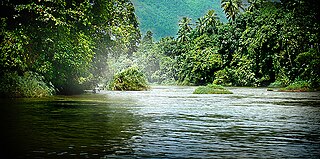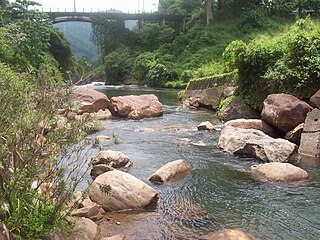
The Kelani River is a 145-kilometre-long (90 mi) river in Sri Lanka. The fourth-longest river in the country, it stretches from the Sri Pada Mountain Range to Colombo. It flows through or borders the Sri Lankan districts of Nuwara Eliya, Ratnapura, Kegalle, Gampaha and Colombo. The Kelani River also flows through the capital of Sri Lanka, Colombo, and provides 80% of its drinking water.

Laxapana Falls is, at 126 m (413 ft) high, the 8th highest waterfall in Sri Lanka and 625th highest in the world. It is situated in Maskeliya area in Nuwara Eliya District, about 16 km (9.9 mi) from Maskeliya town on Maskeliya-Norton Bridge road, in a village called Kiriwan Eliya. It is formed by Maskeliya Oya near the confluence of Kehelgamu Oya and Maskeliya Oya which forms Kelani River. The falls gives its name to twin hydroelectric power stations, Old Laxapana Power Station which generates 50 MW of electricity and New Laxapana Power Station which generates 100 MW.

The Samanala Dam is a dam primarily used for hydroelectric power generation in Sri Lanka. Commissioned in 1992, the Samanalawewa Project is the third-largest hydroelectric scheme in the country, producing 405 GWh of energy annually. It was built with financial support from Japan and the United Kingdom. It is notable for a large leak on its right bank. Power production continues as planned despite the leakage, and the water from the leak now provides two thirds of the water issued by the reservoir for agriculture in downstream areas.

The electricity sector in Sri Lanka has a national grid which is primarily powered by hydroelectric power and thermal power, with sources such as photovoltaics and wind power in early stages of deployment. Although potential sites are being identified, other power sources such as geothermal, nuclear, solar thermal and wave power are not used in the power generation process for the national grid.

Devapura Jayasena Wimalasurendra was a Sri Lankan engineer and statesman. He played a prominent role in the establishment of hydropower in Sri Lanka and is known as the "Father of Hydropower" and was a member of the State Council of Ceylon.

The Broadlands Dam is a 35 MW run-of-the-river hydroelectric complex currently under construction in Kitulgala, Sri Lanka. The project is expected to be completed in 2020, and will consist of two dams, and a power station downstream.
The Bowatenna Dam is a 100 ft (30 m) high gravity dam at Bowatenna, in Central Province of Sri Lanka. The dam was built in June 1981, and is used primarily for irrigation. A 40 MW power station is also constructed 5,800 ft (1,800 m) downstream, for hydroelectric power generation.

The Maskeliya Dam is a large gravity dam at Maskeliya, in the Central Province of Sri Lanka. Along with the Castlereigh Dam, the dams are the highest point and beginning of the Laxapana Hydropower Complex, involving a number of dams, penstocks, and hydroelectric power stations. The dam creates the Maskeliya Reservoir over the route of Maskeliya Oya, a major tributary of the Kelani River, which is the 4th longest in the country.

The Castlereigh Dam is a gravity dam built across the Kehelgamu Oya, a major tributary to the Kelani River, approximately 3 km (1.9 mi) south-west of Hatton, in the Central Province of Sri Lanka.

The Polgolla Barrage is a barrage built across the Mahaweli River at Polgolla, in the Central Province of Sri Lanka. The barrage is used to increase the volume of water, for transfer to the hydroelectric power station located 8 km (5 mi) north, via penstock.

The Canyon Dam is a large arch-gravity dam built across the Maskeliya Oya, 4.5 km (2.8 mi) upstream of the iconic Laxapana Falls, in the Central Province of Sri Lanka. The associated power station plays a major role in the national power grid, due to its significant output. The dam is surrounded by steel structures of the substation.

The Laxapana Dam is a gravity dam built across the Maskeliya Oya, 2.8 km (1.7 mi) downstream of the Laxapana Falls, in the Central Province of Sri Lanka.

The Kehelgamu Oya is a major upstream tributary of the Kelani River. The tributary measures 50 km (31 mi) in length, originating in the hills of the Horton Plains National Park, before passing through the Castlereigh Reservoir. Kehelgamu Oya converges with the Maskeliya Oya at Kalugala, forming the 100 km (62 mi) long Kelani River. The river is heavily used for hydroelectric power generation.

The Maskeliya Oya is a major upstream tributary of the Kelani River. This 40 km (25 mi) long tributary originates in the hills of the Peak Wilderness Sanctuary, before passing through the Maskeliya Reservoir. The Maskeliya Oya converges with the Kehelgamu Oya at Kalugala, forming the 100 km (62 mi) long Kelani River. The river is heavily used for hydroelectric power generation.
The Kukule Ganga Dam is a 110 m (360 ft) gravity dam built across the Kukule River in Kalawana, Sri Lanka. The run-of-river dam feeds an underground hydroelectric power station located approximately 5 kilometres (3.1 mi) away, via tunnel.

The Udawalawe Dam is a large irrigation dam in Udawalawe, in the Southern Province of Sri Lanka. The dam consists of an embankment section and a gravity section, combining the total dam length to approximately 3.9 km (2.4 mi). The dam is also used for hydroelectric power generation, powering two 2 MW units, commissioned in April 1969.

The Gal Oya Dam is an embankment dam in the Uva Province of Sri Lanka. The dam creates one of the largest reservoirs in the country, the Gal Oya Reservoir. Water from the reservoir is used primarily for irrigation in the Uva and Eastern provinces, in addition to powering a small hydroelectric power station. Construction of the dam and reservoir began in August 24, 1949, completing four years later in 1953.
The Nilambe Dam is a small hydroelectric dam build across the Nilambe River, measuring approximately 70 m (230 ft) in length. Water from the Nilambe Dam is transferred to the 3.2-megawatt Nilambe Power Station through a 2.8 km (1.7 mi) penstock. The power station consists of two 1.6 MW generating units, which were commissioned in July 1988.


















